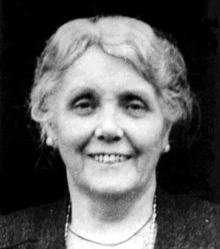Catherine Hogg Blair
Catherine Hogg Blair (née Shields; 8 January 1872 – 18 November 1946)[1] was a Scottish suffragette and founder of the Scottish Women's Rural Institute (SWRI), and member of the Women's Social and Political Union (WSPU).
Catherine Blair | |
|---|---|
 | |
| Born | Catherine Shields 8 January 1872 Byres Farm, Bathgate, Scotland |
| Died | 18 November 1946 (aged 74) North Berwick, Scotland |
| Nationality | Scottish |
| Known for | Suffragette and founder of the Scottish Women's Rural Institute[Establishing Mak'Merry Pottery Studio] |
| Parents |
|
Early life and family
Catherine Blair was born in Byres Farm, Bathgate to Susan Jemima Hogg and James Shields. One of six children, Catherine attended Bathgate Academy The Shields family moved to Dolphingstone Farm, near Tranent. Catherine met and married Thomas Blair, a farmer, in 1894. The couple moved to Hoprig Mains Farm in East Lothian and had four children.[1]
Support of suffrage
Blair was an active member of the Women's Social and Political Union (WSPU), and chaired local meetings and wrote to the press. She did not participate in militant protest because of her young family. Blair established her farm as a clandestine refuge for Scottish suffragettes who had been released from prison under licence as a result of the Cat and Mouse Act.[2] She was a friend of fellow suffragette, Nannie Brown, who also worked on the SWRI.[3]
Scottish Women's Rural Institute
In 1917, Blair identified the need for a Scottish example of the emerging Women's Institutes movement and consequently founded the Scottish Women's Rural Institute. The first SWRI meeting was held in Longniddry, East Lothian, and Madge Watt was there from Canada – 37 women became members. The SWRI created the chance for rural women to forge new social networks and share skills with one another; something Blair was passionate about understanding the obligatory ties women had to their home lives.[4][5]
During the 1921 census she was so annoyed that the census would record her as just "wife" that she moved herself and her children to a nearby barn so that the census form would need to show her as a person in her own right.[6]
She became a magistrate in 1921, and helped set up the Lothian Home Arts Guild of Craftswomen.[3]
Later life
Blair died in North Berwick on 18 November 1946.[5]
References
- Ewan; et al. (2006). The Biographical Dictionary of Scottish Women. Edinburgh: Edinburgh University Press. pp. 38. doi:10.1093/ref:odnb/50066. ISBN 0 7486 1713 2.
- "Catherine Blair, the East Lothian woman who founded 'the Rural'... and a suffragette harbourer!". East Lothian Courier. Retrieved 2018-06-23.
- Andrews, Maggie (2018). Hidden Heroines: The Forgotten Suffragettes. Robert Hale Ltd. p. 103. ISBN 9780719827617.
- "HistoryShelf.org :: Learning SHELF". www.historyshelf.org. Archived from the original on 2015-11-07. Retrieved 2018-06-08.
- "PIONEER OF "RURALS": Death of Mrs Catherine Blair - work for countrywomen". The Scotsman. 19 November 1946. p. 6.
- Barnes, Julie-Anne (2017-03-06). "Great-grandchild of Suffragette who founded SWI helps celebrate centennial year". dailyrecord. Retrieved 2018-06-11.
.jpg)